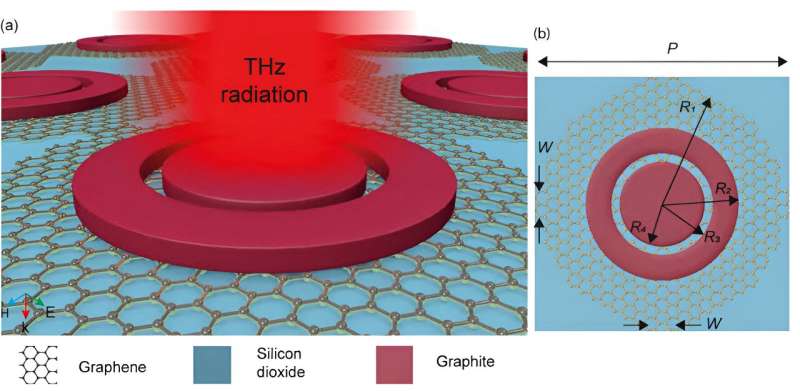This article has been reviewed according to Science X's editorial process and policies. Editors have highlighted the following attributes while ensuring the content's credibility:
fact-checked
trusted source
proofread
New carbon-based tunable metasurface absorber paves the way for advanced terahertz technology

Working in the terahertz (THz) range offers unique opportunities in various applications, including biomedical imaging, telecommunications, and advanced sensing systems. However, because of the unique properties of electromagnetic waves in the 0.1 to 10 THz range, it has proven difficult to develop high-performance components that showcase the true potential of THz technology. Even the design of basic and essential elements like filters and absorbers remains a substantial challenge.
Fortunately, the rise of metamaterials might lead to innovative ways to solve these issues. Thanks to advances in manufacturing and processing technologies, it is now possible to create two-dimensional (2D) patterned microstructures with unique electromagnetic properties in the THz range, providing unprecedented control over signals at these frequencies.
Although various 2D metamaterial (or "metasurface") absorbers have been proposed, most of them still suffer from serious limitations. One common problem is that once the structural pattern of a metasurface absorber is determined and manufactured, its electromagnetic performance becomes fixed. This lack of tunability restricts the possible applications of such devices.
On the other hand, while tunable metal-based metasurface absorbers exist, the use of thin metal layers is discouraged. This is due to several drawbacks, such as the difficulty in manufacturing the necessary structures and lackluster performance caused by the inherent characteristics of metals.
Against this backdrop, a research team from China has now developed a new carbon-based tunable metasurface absorber with an ultrawide, tunable bandwidth in the THz range. Their study, directed by Dr. Wenhan Cao of ShanghaiTech University, was published in Advanced Photonics Nexus.
The proposed absorber is centered around the use of graphene and graphite microstructures as resonators and a graphite layer as a back-reflecting surface. "The repeating subunit, or 'unit cell,' in this THz metasurface absorber was strategically designed to optimize absorption efficiency mainly based upon four factors: geometry, material properties, polarization sensitivity, and tuning mechanisms," explains Cao.
In terms of geometry, the absorber comprises three thin layers. The top layer is a patterned conductive layer containing an arrangement of concentric graphite rings interconnected by graphene wires, while the second one is a simple dielectric that helps dissipate unwanted electromagnetic waves. Finally, the third layer is an absorption layer that prevents THz waves from transmitting right through the device, thus maximizing absorption efficiency.
Both the material selection and the geometric design of the absorber, which was optimized through numerical analysis and simulations, contribute to its remarkable absorption in the THz range. Notably, a key characteristic of the proposed absorber is its tunability, which arises from an adjustable Fermi level. This parameter is essential in materials and semiconductor technology as it determines the distribution of electrons at different energy levels.
By applying a voltage to the graphene layer, it is possible to modify its Fermi level, which in turn enables one to easily fine-tune the absorption bandwidth.
"At a Fermi level of 1 eV, the proposed absorber can achieve an impressively wide bandwidth of 8.99 THz, delivering over 90% absorption within the frequency range of 7.24 to 16.23 THz, with two distinct resonance peaks at 8.35 THz and 14.70 THz," added Cao.
Another notable advantage of the proposed design is its remarkable insensitivity to the polarization angle of incident radiation. This favorable property arises naturally from the use of concentric rings in the unit cell of the absorber. The circle, as a perfectly symmetrical shape, enables the absorber to maintain high absorption rate at incident angles of up to 50°.
Overall, the many benefits of the proposed design, combined with its elegant simplicity, represent a true breakthrough in THz technology.
"The proposed absorber provides an ultra-thin and simple metal-free structure with a wide and tunable absorption bandwidth at a low thickness, which greatly enhances its applicability. These advantages go beyond those of other reported absorbers," said Cao.
Soon, THz devices could become part of everyday technology, especially in fields such as medicine and communications, as well as in more research-oriented endeavors like materials science and biology.
More information: Aiqiang Nie et al, Carbon-based ultrabroadband tunable terahertz metasurface absorber, Advanced Photonics Nexus (2024). DOI: 10.1117/1.APN.3.1.016007
Provided by SPIE





















